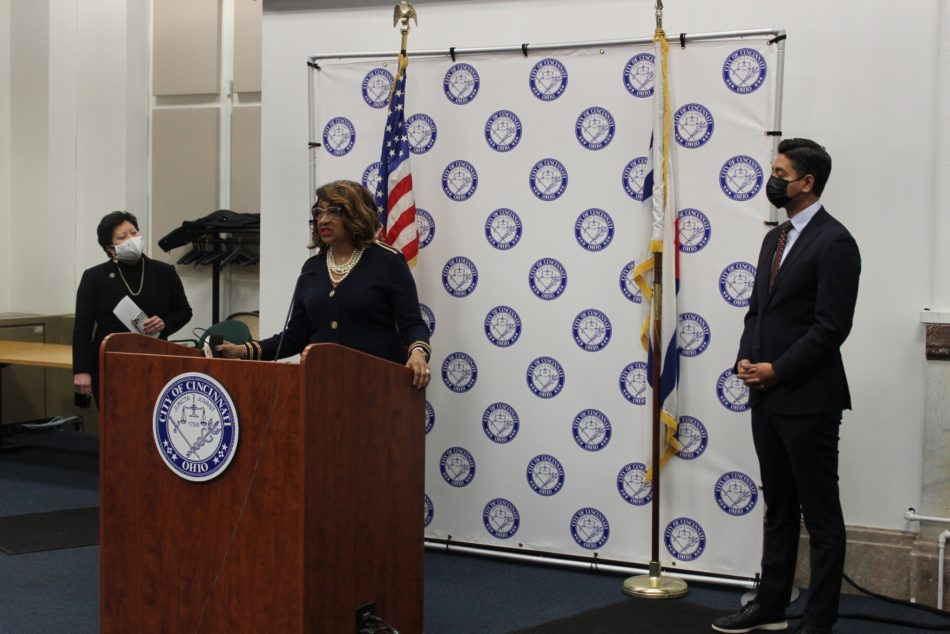Cincinnati’s Health Commissioner confirmed Tuesday the city’s first case of the omicron variant of coronavirus occurred Dec. 12.
Melba Moore announced the news during a COVID-19 update at City Hall. She says only one case has been seen in Cincinnati, and urged the community to continue wearing masks, get vaccinated and get tested.
“The message doesn’t stray,” Moore said. “I’m saying this all the same: wear a mask. I can be somewhere and be the only one with this on. That’s OK. I am going to wear this, [I’ll] socially distance, and if I’m a hermit, I’m a hermit. But that’s what I am going to do and that’s the message.”
On Tuesday, 128 new COVID-19 cases in Cincinnati were reported. More than 42,000 COVID-19 cases have been confirmed within the city during the pandemic. Of those infected, 523 people have died.
Mayor John Cranley says the definition of “fully vaccinated” should be reconsidered to include a booster shot.

“I assume very much that my wife and I and my son will be getting some kind of booster every year for the rest of our lives,” Cranley said.
Mayor-elect Aftab Pureval says the community can’t move past the pandemic if this isn’t taken seriously. He asked people to get vaccinated and spoke of his wife’s background as a doctor working within a local hospital.

“She treats COVID patients every day,” he said. “And hospitals from the very beginning of this pandemic -and the frontline workers that work at hospitals and other essential services – have been day after day taking the brunt of this.”
Omicron spreads easier than other strains
During Tuesday’s Hamilton County Commission meeting, Health Commissioner Greg Kesterman addressed concerns of the omicron variant, specifically the amount of time it takes to infect people compared to the delta variant.
“The delta variant, my understanding is the doubling time – how long it would take twice as many people to get sick was about seven days, and the omicron variant is two days,” Kesterman said. “Over the course of a week, you’re making seven times more people ill from omicron.”
Over the weekend, cases involving the variant were confirmed in two counties in Northern Kentucky (Kenton and Campbell). The first two cases of the variant in Ohio were in vaccinated men who had tested positive for COVID-19 on Dec. 7.
Omicron is now the dominant COVID strain in the U.S., making up 73% of new infections. President Joe Biden announced Tuesday the government plans to buy a half-billion at-home COVID test kits and mail them to people who want them. Defense Secretary Lloyd Austin will mobilize 1,000 doctors, nurses, medics and other military medical personnel to deploy to hospitals in January and February.

Hospitalizations near previous peak
Cases and hospitalizations within the Greater Cincinnati region are reaching peak levels again heading into the end of the year.
Within the last seven days, 38 deaths in Hamilton County were caused by the virus. Since last week, the county has averaged at least two per day. Kesterman says this is a lagging indicator.
“So if you had 100 people in the ICU today, it would take a little while for those to translate into outcomes so some will get better, and about half will not make it out of the ICU,” Kesterman said.
At least 642 COVID-19 patients are in the region’s hospitals. Of those, 178 are in the ICU and 120 are on ventilators. Nearly 1,600 have died from COVID-19 in Hamilton County during the pandemic.
According to the CDC COVID Data Tracker, Hamilton County is averaging more than 535 cases per 100,000 people. The county’s positivity rate is above 11% and there are roughly 9,100 active cases.
Within the region, at least 74% of those ages 12 or more have received at least one dose of a COVID-19 vaccine.


